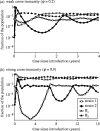Integrating life history and cross-immunity into the evolutionary dynamics of pathogens
- PMID: 16615206
- PMCID: PMC1560197
- DOI: 10.1098/rspb.2005.3335
Integrating life history and cross-immunity into the evolutionary dynamics of pathogens
Abstract
Models for the diversity and evolution of pathogens have branched into two main directions: the adaptive dynamics of quantitative life-history traits (notably virulence) and the maintenance and invasion of multiple, antigenically diverse strains that interact with the host's immune memory. In a first attempt to reconcile these two approaches, we developed a simple modelling framework where two strains of pathogens, defined by a pair of life-history traits (infectious period and infectivity), interfere through a given level of cross-immunity. We used whooping cough as a potential example, but the framework proposed here could be applied to other acute infectious diseases. Specifically, we analysed the effects of these parameters on the invasion dynamics of one strain into a population, where the second strain is endemic. Whereas the deterministic version of the model converges towards stable coexistence of the two strains in most cases, stochastic simulations showed that transient epidemic dynamics can cause the extinction of either strain. Thus ecological dynamics, modulated by the immune parameters, eventually determine the adaptive value of different pathogen genotypes. We advocate an integrative view of pathogen dynamics at the crossroads of immunology, epidemiology and evolution, as a way towards efficient control of infectious diseases.
Figures




Similar articles
-
Vaccination and the dynamics of immune evasion.J R Soc Interface. 2007 Feb 22;4(12):143-53. doi: 10.1098/rsif.2006.0167. J R Soc Interface. 2007. PMID: 17210532 Free PMC article.
-
Bordetella pertussis strain variation and evolution postvaccination.Expert Rev Vaccines. 2009 Jul;8(7):863-75. doi: 10.1586/erv.09.46. Expert Rev Vaccines. 2009. PMID: 19538113 Review.
-
Ecological interference between fatal diseases.Nature. 2003 Apr 24;422(6934):885-8. doi: 10.1038/nature01542. Nature. 2003. PMID: 12712203
-
Adaptation of Bordetella pertussis to vaccination: a cause for its reemergence?Emerg Infect Dis. 2001;7(3 Suppl):526-8. doi: 10.3201/eid0707.017708. Emerg Infect Dis. 2001. PMID: 11485646 Free PMC article.
-
Pertussis: a matter of immune modulation.FEMS Microbiol Rev. 2011 May;35(3):441-74. doi: 10.1111/j.1574-6976.2010.00257.x. Epub 2011 Jan 5. FEMS Microbiol Rev. 2011. PMID: 21204863 Review.
Cited by
-
Substantial Impact of Post Vaccination Contacts on Cumulative Infections during Viral Epidemics.medRxiv [Preprint]. 2020 Dec 24:2020.12.19.20248554. doi: 10.1101/2020.12.19.20248554. medRxiv. 2020. Update in: F1000Res. 2021 Apr 23;10:315. doi: 10.12688/f1000research.52341.1. PMID: 33398300 Free PMC article. Updated. Preprint.
-
Portable solutions for plant pathogen diagnostics: development, usage, and future potential.Front Microbiol. 2025 Jan 31;16:1516723. doi: 10.3389/fmicb.2025.1516723. eCollection 2025. Front Microbiol. 2025. PMID: 39959158 Free PMC article. Review.
-
Mixed allele malaria vaccines: host protection and within-host selection.Vaccine. 2008 Nov 11;26(48):6099-107. doi: 10.1016/j.vaccine.2008.09.004. Epub 2008 Sep 18. Vaccine. 2008. PMID: 18804509 Free PMC article.
-
Horizontally acquired divergent O-antigen contributes to escape from cross-immunity in the classical bordetellae.BMC Evol Biol. 2013 Sep 25;13:209. doi: 10.1186/1471-2148-13-209. BMC Evol Biol. 2013. PMID: 24067113 Free PMC article.
-
Timing of pathogen adaptation to a multicomponent treatment.PLoS One. 2013 Aug 21;8(8):e71926. doi: 10.1371/journal.pone.0071926. eCollection 2013. PLoS One. 2013. PMID: 23991006 Free PMC article.
References
-
- Anderson R.M, May R.M. Population biology of infectious diseases: part I. Nature. 1979;280:361–367. doi:10.1038/280361a0 - DOI - PubMed
-
- Anderson R.M, May R.M. Coevolution of hosts and parasites. Parasitology. 1982;85:411–426. - PubMed
-
- Anderson R.M, May R.M. The invasion, persistence and spread of infectious diseases within animal and plant communities. Phil. Trans. R. Soc. B. 1986;314:533–570. - PubMed
-
- Anderson R.M, May R.M. Oxford University Press; Oxford, UK: 1991. Infectious diseases of humans: dynamics and control.
-
- Anderson R.M, Fraser C, Ghani A.C, Donnelly C.A, Riley S, Ferguson N.M, Leung G.M, Lam T.H, Hedley A.J. Epidemiology, transmission dynamics and control of SARS: the 2002–2003 epidemic. Phil. Trans. R. Soc. B. 2004;359:1091–1105. doi:10.1098/rstb.2004.1490 - DOI - PMC - PubMed
Publication types
MeSH terms
LinkOut - more resources
Full Text Sources
Medical
Molecular Biology Databases

